|
|
|
| My Favourite Planet > English > Europe > Greece > Macedonia > Stageira & Olympiada |
| Stageira & Olympiada |
History of Stageira & Olympiada - Part 5 |
|
 |
page 6 |
 |
|
| |

The Classical stoa of Stageira's agora (market place). See Ancient Stageira gallery pages 22-25. |
| |
History of Ancient Stageira - Part 5
Athenians and Spartans,
5th - 4th centuries BC |
| |
The Delian League - the Athenian empire,
477-404 BC
Xerxes' invasion of Greece had been repulsed, but at great cost to the Greek states, many of whose cities had been destroyed, and their farmlands ravaged. Around 477 BC several of the states, including Stageira, formed the Delian League as an alliance against the Persians, and with the express intention of revenge [25]. Athens, which had emerged from the Persian wars as the strongest of these states with the most powerful navy, came to dominate the league.
Delegates of member states met at the temple of Apollo on the sacred island of Delos and agreed to either provide troops and ships or pay a tribute to a common fund which was kept in the league's treasury on the island. The amounts each city was to pay was inscribed on large marble steles known as tribute lists or quota lists (see photo below right) which were displayed on the Athens Acropolis. Stageira paid one talent per year to this fund. But in 454 BC Pericles removed the treasury to Athens. Dissent or resignation from the league was not tolerated by Athens which used considerable force to keep members in line.
The dominance of Athens and the league, and the consequent shift in the balance of power in the Aegean, alarmed non-member Greek States, particularly Sparta. This tension was one of the factors leading to the Peloponnesian War between Athens and Sparta and their respective allies 431-404 BC.
The situation in Halkidiki was further complicated by the attempts by King Perdiccas II of Macedonia to persuade the cities there to revolt against Athens, and the fact that Potidaia was an important colony of Corinth. From the Battle of Potidaia in 432 BC to the Battle of Spartolos in 429 BC, Athens found itself fighting against cities of Halkidiki allied by Corinth, Macedonia and Sparta. The Athenians came off badly, in terms of human and financial losses, and cities such as Olynthos became more determined to break from Athens.
Around 430 BC, several rebel cities of Halkidiki formed their own alliance, known as the Chalcidian League, headed by Olynthos. Stageira may have been a member of this league [26], however in 429-428 BC it was among the few cities of Halkidiki - along with Mende, Aphytis, Scione and Akanthos - still paying the tribute to Athens.
In 424 BC the Spartan general Brasidas (Βρασίδας) led an army through Greece to Macedonia at the request for help from King Perdiccas II, and persuaded several cities, including Akanthos, Stageira and Argilos to secede from the Delian League. [27] He then marched to Amphipolis with troops supplied by these new allies, and persuaded the inhabitants of the Athenian colony to defect.
At the end of a one year armistice between Athens and Sparta, in 422 BC the Athenian politican Cleon (Κλέων) led a force to try to recapture the northern territories. He unsuccessfully besieged Stageira [28], and was defeated and killed in the Battle of Amphipolis when he attempted to take the city. Brasidas also died in the battle, and the Athenians and Spartans eventually reached a truce, the Peace of Nikias of 421 BC, which ensured the independence and neutrality of the cities of Halkidiki but also stipulated that they should continue to pay the tribute to the Delian League. [29]
However, by this time the warring Greek states were concentrating on other locations, and Athens had become so weakened by war and plague that it could no longer enforce its claim to tribute from many of the cities or destroy the Chalcidian League. Ironically, it was Sparta which was to defeat Olynthos and dissolve the league in 379 BC, although it was able to reform a few years later. [30] |
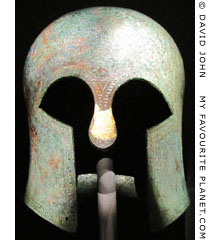
Corinthian helmet.
Bronze, late 6th century BC.
Thessaloniki Archaeological
Museum. |
| |
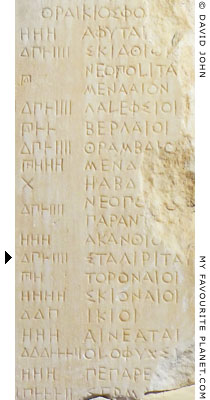
Detail of the second stele of
the tribute lists of the Delian
League for the years 439/8
- 432/1 BC, with the names
of Thracian cities in the right
column, and the amount
each city was to pay in the
left column (in ancient
Greek numerals).
The name of Stageira
(marked with an arrow-head)
appears below that of
Akanthos and above Torone
(Τορώνη), another colony of
Chalcis in Halkidiki, on the
southwestern coast of
the Sithonia peninsula.
The name of the Stageirites is
written ΣΤΑΓΙΡΙΤΑΙ (Stagiritai),
and as elsewhere on the stele,
the letter Γ (gamma) appears
like a Λ (lambda).
Epigraphical Museum, Athens.
Inv. No. EM 6857+6648+.
Inscription IG I(3) 273-280. |
| |
| |
Stageira &
Olympiada
History
part 5 |
Notes, references and links |
 |
|
25. Thucydides on the formation of the Delian League,
circa 477 BC
Thucydides (Greek, Θουκυδίδης, Thoukydides; circa 460-395 BC), Greek historian and author from Alimos (Άλιμος), a coastal district of Athens. He also owned an estate including gold mines at Scapte Hyle (Σκαπτὴ Ὕλη, a forest that may be dug; also referred to as Scaptensula, foss wood), near Neapolis (today Kavala), on the coast opposite the island of Thasos.
See:
Thucydides, The Peloponnesian War, Book 4, chapter 105, section 1. At Perseus Digital Library.
Plutarch, Lives: Cimon, Chapter 4. At Perseus Digital Library.
It was at Scapte Hyle that Thucydides spent his last years, following his banishment from Athens, and completed his work History of the Peloponnesian War (Ιστορία του Πελοποννησιακού Πολέμου), an account of the war between Athens and Sparta in the 5th century BC. Although quite different in style and approach to Herodotus' Histories, it continues historically from where Herodotus left off, at the end of the Greek-Persian wars. In turn, the Athenian soldier and historian Xenophon (see below) continued the story in his own way.
"The Athenians, having thus succeeded to the supremacy by the voluntary act of the allies through their hatred of Pausanias [the Spartan general], fixed which cities were to contribute money against the barbarian, which ships; their professed object being to retaliate for their sufferings by ravaging the King's country.
Now was the time that the office of 'Treasurers for Hellas' was first instituted by the Athenians. These officers received the tribute, as the money contributed was called. The tribute was first fixed at four hundred and sixty talents. The common treasury was at Delos, and the congresses were held in the temple. Their supremacy commenced with independent allies who acted on the resolutions of a common congress."
Thucydides, The History of the Peloponnesian War, Book 1, chapter 4. Translated by Richard Crawley (1840-1893), 1874. At Project Gutenberg.
This and all other quotes from Thucydides below are from the translation by Richard Crawley (1840-1893), at Project Gutenberg.
The entire work is on a single web page and is also available in other formats. |
|
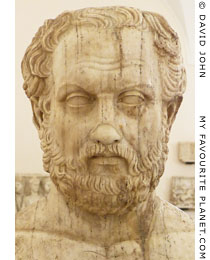
Marble bust of Thucydides.
From a double herm of
Herodotus and Thucydides.
Early 2nd century AD copies
of Greek originals of the early
4th century BC.
National Archaeological
Museum, Naples.
Inv. No. 6239. |
|
 |
26. Stageira and the Chalcidian League
Not much is known about the exact form, constitution or membership of the Chalcidian League (Greek, Κοινόν τῶν Χαλκιδέων, Koinon of the Chalcideans), and the Greek word koinon is variously interpreted as commonwealth, league or federation. Olynthos was certainly at its head, offered "joint citizenship and common laws" to members (Xenophon, Hellenica, Book 5, chapter 2, sections 11-19, see below), and issued a common coinage showing a lyre, the symbol of Apollo. The league was alternately allied with and opposed by Sparta and Macedonia, and was eventually broken up by Philip II of Macedon in 348 BC (see History part 6).
It is thought that Stageira was a member of the Chalcidian League, which would also help explain why it appears to have ceased minting its own coins:
"In any case other evidence shows that Stageiros was a member of the Chalcidian League at the time of its destruction by Philip. Thus its coinage can be assigned only to the first quarter of the fourth century."
"The destruction of Stageiros is mentioned by Plut. Alex., 7, and we know from other sources that it was a member of the Chalcidian League, Strabo, VII, 331, frg. 35; Dion Chrys., XLVII, 9."
Allen Brown West, The history of the Chalcidic League, pages 122 and 133. University of Wisconsin, 1919.
Although West claimed that there is evidence that Stageira was a member of the Chalcidian League, the only two sources he cited are far from convincing. The name Chalcidian League is an invention of modern historians; ancient writers referred to the alliance as "Chalcidice", "the Chalcidians (of Thrace)" or simply to "the Olynthians", as Olynthos was the leading city, without naming the member cities, thus lumping the territories of the Halkidiki peninsula together.
Both the geographer Strabo (Στράβων, 64/63 BC – circa 24 AD) and the orator Dio Chrysostom (Δίων Χρυσόστομος, circa 40-120 AD) lived over 300 years after the demise of the League. Strabo states merely that Stageira "belongs to the Chalcidians". Dio Chrysostom claimed "Stageira was a village in the territory of Olynthus", but this is hardly evidence that it joined the League, at least not before the Peace of Nikias of 421 BC. It may have been forced to join the league some time before 383 BC (see note 30 on Xenophon below).
Strabo, The Geography, Book 7, fragments, 1a - 60, edited by H. L. Jones. Harvard University Press, Cambridge, Mass.; William Heinemann Ltd, London. 1924. At Perseus Digital Library.
Dio Chrysostom, Discourses, 7, section 9. Translated by J. W. Cohoon and H. Lamar Crosby. Loeb Classical Library, Harvard University Press, 1946. At Bill Thayer's LacusCurtius: Into the Roman World, University of Chicago.
As for the lack of evidence of coins minted by Stageira at the end of the Classical period, there seems to be no evidence either that it used Olynthian coinage. During the time of the Delian League it may have used Athenian coinage following its imposition by decree in the 420s BC:
"The secretary of the [Athenian] council shall for the future add the following to the council’s oath:
'If anyone mints silver coinage in the cities, and does not use Athenian coinage, weights and measures but uses foreign coinage, measures and weights, I shall punish and penalise him in accordance with the earlier decree proposed by Clearchus.'"
R. Meiggs, and D. M. Lewis, A selection of Greek historical inscriptions to the end of the fifth century BC, 45, section 12. Oxford University Press, 1988. |
|
 |
|
27. Thucydides on Brasidas and the Halkidiki revolt, 424 BC
"Such were the words of Brasidas. The Acanthians, after much had been said on both sides of the question, gave their votes in secret, and the majority, influenced by the seductive arguments of Brasidas and by fear for their fruit, decided to revolt from Athens; not however admitting the army until they had taken his personal security for the oaths sworn by his government before they sent him out, assuring the independence of the allies whom he might bring over. Not long after, Stagirus, a colony of the Andrians, followed their example and revolted. Such were the events of this summer."
Thucydides, Book 4, chapter 14.
According to Plutarch, Brasidas was also honoured by the citizens of Akanthos.
"The treasury of the Acanthians at Delphi bears this inscription: 'Brasidas and the Acanthians, with spoil from the Athenians.' For this reason many think that the marble figure standing within the edifice, by the door, is a statue of Brasidas. But it really represents Lysander..."
"Out of the spoils, Lysander set up at Delphi bronze statues of himself and each of his admirals, as well as golden stars of the Dioscuri, which disappeared before the battle of Leuctra [an omen of the Spartans defeat in the battle, 371 BC]. And in the treasury of Brasidas and the Acanthians there was stored a trireme two cubits long [90 cm], made of gold and ivory, which Cyrus sent Lysander as a prize for his victory."
Plutarch, The Parallel Lives, The Life of Lysander, chapters 1 and 18. At Bill Thayer's LacusCurtius website.
According to a passage in the Varia Historia (Various History) of the Roman writer Aelian, the Athenian philosopher Socrates (Σωκρᾰ́της, circa 470-399 BC) fought at Amphipolis and Potidaia.
"But Socrates would not meddle with the Athenian State, because the Democracy of the Athenians did at that time more resemble a Tyrannical and Monarchick Government. Neither would he joyn in sentencing the ten Commanders to death, nor partake of the injustices committed by the thirty Tyrants. But when occasion called him forth, he was a Souldier. He fought at Delium, and at Amphipolis and Potidea."
Claudius Aelianus, His Various History, Book 3, chapter 17. Translated by Thomas Stanley. Thomas Dring, London, 1665. At James Eason's website, University of Chicago.
28. Thucydides on Cleon's siege of Stageira,
422 BC
"Cleon, whom we left on his voyage from Torone to Amphipolis, made Eion his base, and after an unsuccessful assault upon the Andrian colony of Stagirus, took Galepsus, a colony of Thasos, by storm."
Thucydides, Book 5, chapter 15.
29. Thucydides on the Peace of Nikias, 421 BC
"This arranged, the Lacedaemonians summoned their allies, and all voting for peace except the Boeotians, Corinthians, Eleans, and Megarians, who did not approve of these proceedings, they concluded the treaty and made peace, each of the contracting parties swearing to the following articles:
The Athenians and Lacedaemonians and their allies made a treaty, and swore to it, city by city, as follows:"
. . .
"5. The Lacedaemonians and their allies shall give back Amphipolis to the Athenians. Nevertheless, in the case of cities given up by the Lacedaemonians to the Athenians, the inhabitants shall be allowed to go where they please and to take their property with them: and the cities shall be independent, paying only the tribute of Aristides. And it shall not be lawful for the Athenians or their allies to carry on war against them after the treaty has been concluded, so long as the tribute is paid. The cities referred to are Argilus, Stagirus, Acanthus, Scolus, Olynthus, and Spartolus. These cities shall be neutral, allies neither of the Lacedaemonians nor of the Athenians: but if the cities consent, it shall be lawful for the Athenians to make them their allies, provided always that the cities wish it. The Mecybernaeans, Sanaeans, and Singaeans shall inhabit their own cities, as also the Olynthians and Acanthians: but the Lacedaemonians and their allies shall give back Panactum to the Athenians."
Thucydides, Book 5, chapter 15. |
| |
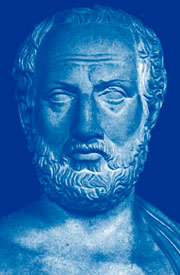
Marble bust of Thucydides.
Thought to be a Roman copy
of a 4th century BC original.
Holkham Hall, Norfolk, England.
Source: Anton Hekler (1882-1940),
Greek & Roman portraits.
Putman, New York, 1912.
At the Internet Archive. |
| |
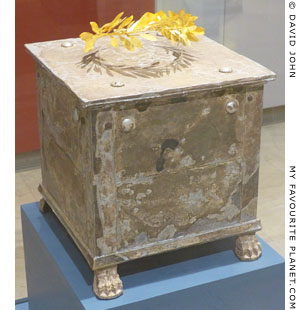
The silver ossuary of the Spartan general
Brasidas, which contained his ashes and
a gold olive wreath.
According to Thucydides, Brasidas was
buried with honours inside the walls of
Amphipolis after being killed during the
unsuccessful siege of the city by the
Athenian general Cleon (422 BC), who
also died in the battle. The Amphipolitans
worshipped Brasidas as a hero and true
oikistes (οἰκιστής, founder) of the city.
Discovered in a cist grave of poros
(limestone) blocks, cut into the soft
natural rock beneath the Amphipolis
Archaeological Museum, during its
construction in 1976. The grave, which
was found sealed and unlooted, can still
be seen in situ beneath the building.
Amphipolis Archaeological Museum,
Macedonia, Greece. |
| |
|

A sketch map of the Battle of Amphipolis.
- - - - Modern Roads
==== Ancient Roads
1. Thracian Gate
2. First Gate in the Long Wall
3. Gate from the town into space enclosed by the palisade
4. Gate in the palisade
Lake Kerkinitis, once famous for its eels, was drained in the 20th century.
|
Source: Thucydides, History Peloponnesian War, Volume 3 (of 4), page 11.
Translated by Charles Forster Smith. Loeb Classical Library. Harvard University Press,
Cambridge, Massachusetts; William Heinemann, London, 1959. At the Internet Archive. |
| |
30. Xenophon on the Chalcidian League
According to Xenophon (Ξενοφῶν, circa 430-354 BC), Akanthos and Apollonia sent abassadors to Sparta (in 383 BC), requesting help and claiming that Olynthos was attempting to force them and other cities to join the Chalcidian League. He gives this plea as the reason Sparta attacked Olynthos in 379 BC and dissolved the league.
Xenophon, Hellenica, Book 5, chapter 2, sections 11–19. Xenophon in Seven Volumes, 1 and 2. Edited by Carleton L. Brownson. Harvard University Press, Cambridge, MA; William Heinemann Ltd., London.
Vol. 1, 1918; Vol. 2, 1921. At Perseus Digital Library.
See also: Victor Parker, Sparta, Amyntas and the Olynthians in 383 BC: A comparison of Xenophon and Diodorus, Rheinisches Museum für Philologie, 146 (2003). Sauerländer Verlag, Frankfurt am Main. At Digitale Sammlungen der Universität zu Köln. |
|
|
Photos, maps and articles: copyright © David John,
except where otherwise specified.
Additional photos: copyright © Konstanze Gundudis
All photos and articles are copyright protected.
Images and materials by other authors
have been attributed where applicable.
Please do not use these photos or articles without permission.
If you are interested in using any of the photos for your website,
project or publication, please get in contact.
Higher resolution versions are available on request.
My Favourite Planet makes great efforts to provide
comprehensive and accurate information across this
website. However, we can take no responsibility for
inaccuracies or changes made by providers of services
mentioned on these pages. |
| |
 |
Visit the My Favourite Planet Group on Facebook.
Join the group, write a message or comment,
post photos and videos, start a discussion... |
|
|
| |
|
|
| |
| |
 |
| |
 |
| |
 |
| |
 |
| |
George Alvanos
rooms in
Kavala's historic Panagia District
Anthemiou 35,
Kavala, Greece
kavalarooms.gr
|
| |
 |
| |
 |
| |
Olive Garden Restaurant
Kastellorizo,
Greece
+30 22460 49 109
kastellorizo.de
|
| |
Papoutsis
Travel Agency
Kastellorizo,
Greece
+30 22460 49 286
greeklodgings.gr
|
| |
|